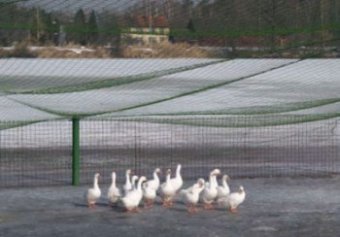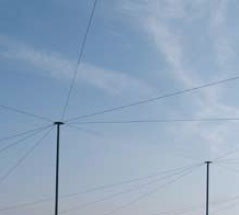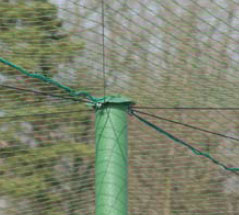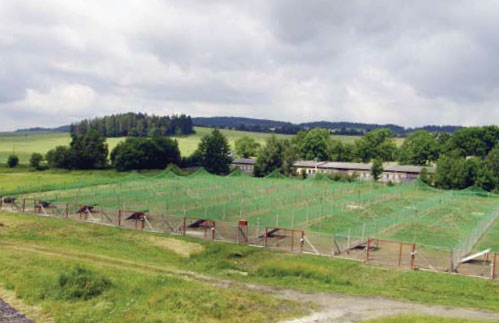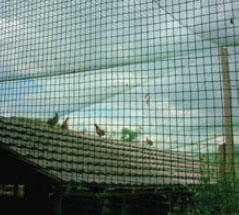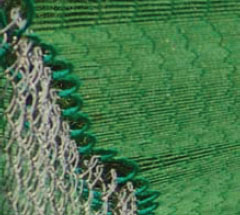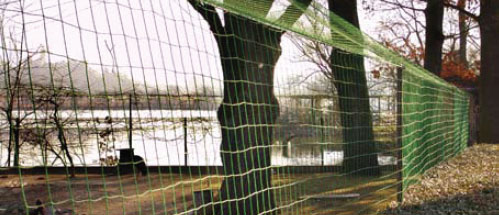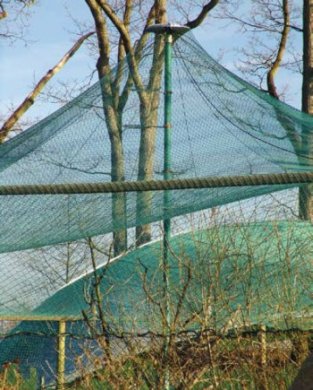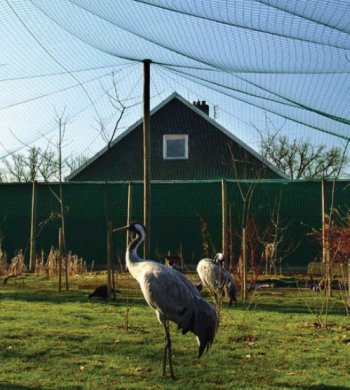Industrial netting
Aviary netting
Aviary netting provides an affordable and optimal solution for free-run fencing and covering for poultry, pheasantries, goose-, duck-, ostrich- or ornamental birds-breeding farms etc.
- Prevents kept animals from escaping into the wild
- Provides greater security and freedom for kept animals
- Improves medical and physical condition of kept animals and your farm exterior
- Protects kept animals against birds of pray
- Prevents transmission of diseases from wildlife
- Prevents feed loss - don’t feed feral animals
Advantages of protection netting for aviary constructions
Nets are lightweight - Even with large aviary surface areas, there is no need to use expensive and heavy building elements.
Easy installation - In most cases, you can install them by yourself without the need to use expensive mechanization.
Nets are deliver in our “pack-up & hang” system - Upon request we can deliver all necessary hanging accessories including the manual.
Price - Taking into account the durability and service life of nets compared with different materials, the price is more than reasonable.
If you use optimal kind of net and install it correctly, life expectancy can be more than 10 years..
Aviary bird netting does not protect kept animals against land predators (foxes, martens, weasels or cats etc).
The aviary construction is composed of peripheral poles, steel-wire ropes and separate supporting poles.
We also recommend to add wire netting (with appropriate mesh size) to aviary sides above ground.
Delivery of protection netting
We provide made to measure nets (whole netting size or cut-to-size pieces).
Size of part or the whole net is only limited by manipulability at hanging and installation The maximal recommended net size is up to 1000 m2.
Aviary nets can be customized to individual size or shape (the net itself can be tailored to fit aviary shape).
Reinforced stitched net border – selvedge edge
The netting surface area can be also reinforced with sewed-in rope or cord upon request. However, this option is not standard.
The net is layed on a “grate” made of coated steel-rope wire. On top of that, the grate is usually supported by iron or wooden studs. (See the drawing & photo)
To achieve high durability and lifespan of your net, use adequate net support.
Building element dimensions should take into account aviary size and weather conditions - wind, snow. (A statics analysis is recommended.)
The top of the supporting poles must contain a sliding surface/cover for the net to move on. Under this cover run steel-wire ropes.
Never fix the net to anchoring steel-wire ropes inside its surface. This may cause the net to be torn.
The net should be fixed only around aviary perimeter. The net should be laid loose on supporting poles and steel-rope wires.
In the first step, connect aviary roof and sides every 2-4 m. If there are any creases on the net surface, move the net until its whole surface area is evenly distributed.
Pay attention to uneven net surface distribution or near its edges.
Uneven distribution (creases) of net or overstrained netting may result in rips.
How you can fix our netting
- PVC-coated iron clamp - recommended
- Plastic strip
- String (labour-consuming but cheap)
The net should be fixed around its perimeter every 40 mm or in every mesh eyelet.
You can fix the net roof, side and peripheral suspension cable at the same time.
Materiál
| Material | Mesh/thickness (mm) | Weight/mm2 | Colour |
|---|---|---|---|
| Polyethylene | 25/2 | 0.120kg/m2 | Green |
| Polyethylene | 40/2 | 0.055kg/m2 | Green |
| Polyethylene | 45/3 | 0.125kg/m2 | Green, black |
| Polyethylene | 70/3 | 0.085kg/m2 | Green, black |
| Polyethylene | 100/3 | 0.058kg/m2 | Green, black |
Doplňky k pověšení
| Material | Thickness (mm) | Strength (kN) |
|---|---|---|
| Galvanized steel-wire rope | 3.15 | |
| PVC coated galvanized steel-wire rope | 3.15/5 | |
| Steel-wire rope clamp | ||
| Tension screw | 10 | |
| Galvanized snap-hook | 50 | |
| Black UV stabilised plastic strip | 5x100 | |
| PVC coated galvanized mesh clamp | ||
| Plaited cord | 3-4 |
